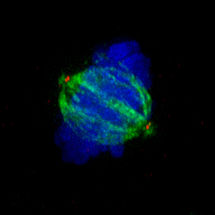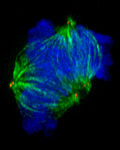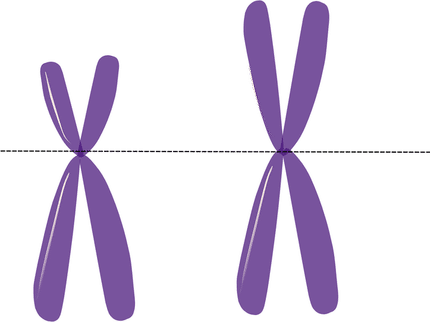Impaired cell division leads to neuronal disorder
Prof. Erich Nigg and his research group at the Biozentrum of the University of Basel have discovered an amino acid signal essential for error-free cell division. This signal regulates the number of centrosomes in the cell, and its absence results in the development of pathologically altered cells. Remarkably, such altered cells are found in people with a neurodevelopmental disorder, called autosomal recessive primary microcephaly. The results of these investigations have been published in Current Biology.

Normal separation of chromosomes (blue) with two centrosomes (red) in a bipolar spindel apparatus (green).
Universität Basel

Flawed separation of chromosomes (blue) with several centrosomes (red) in a multipolar spindel apparatus (green).
Universität Basel


Cell division is the basis of all life. Of central importance is the error-free segregation of genetic material, the chromosomes. A flawless division process is a prerequisite for the development of healthy, new cells, whilst errors in cell division can cause illnesses such as cancer. The centrosome, a tiny cell organelle, plays a decisive role in this process.
Prof. Erich Nigg’s research group at the Biozentrum of the University of Basel has investigated an important step in cell division: the duplication of the centrosome and its role in the correct segregation of the chromosomes into two daughter cells. The protein STIL has an essential function in this process. It ensures that centrosome duplicate before one half of the genetic material is transported into each of the two daughter cells.
KEN-Box important for protein breakdown
During cell division, the protein STIL is degraded. If this does not occur, the protein accumulates in the cell, which then causes an overproduction of centrosomes. As a consequence, mis-segregated chromosomes are incorporated into the daughter cells, which then represent cells with faulty genetic material. The scientists discovered an amino acid signal on the STIL protein, a so-called KEN-Box, and showed that this is critical for the breakdown of the protein: “The Ken-Box is the signal that orders the protein degradation machinery to break down the STIL protein,” explains Christian Arquint, the first author of this publication. In the absence of the KEN-Box, the protein is not degraded.
Absence of the KEN-Box causes microcephaly
In some patients with microcephaly, a neuronal disorder that leads to a reduced number of nerve cells being produced and, therefore, a smaller brain, the KEN-box is lacking from the STIL protein. The scientists were thus able to demonstrate a tantalizing connection between the absence of this particular amino acid signal and an illness. “When during our investigations of cell division and centrosome duplication we came across a connection to the disorder microcephaly, we were particularly pleased, as this helps us to better understand how this disorder develops,“ says Christian Arquint.
In the future, the research group led by Erich Nigg plans to uncover other connections between errors of cell division and the illness microcephaly. They also want to focus on the investigation of other proteins that play important roles in the process of cell division, in particular those involved in centrosome duplication.





















































